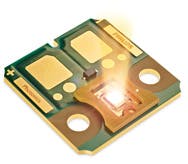Philips Photonics completes $27M project to advance VCSEL production
Philips Photonics (Ulm, Germany), a provider of vertical-cavity surface-emitting laser (VCSEL) technology solutions for data communications, consumer, and industrial applications, announced the successful completion of its 'VIDaP' project (VCSEL Pilot Line for Illumination, Datacom and Power Applications), a 23 million euro (more than $27M dollars) project jointly sponsored by the German Federal Ministry of Education and Research (BMBF) and the EU, and executed under the umbrella of theEuropean ECSEL program.
RELATED ARTICLE: TCAD software facilitates comprehensive VCSEL modeling
Philips says these production advances will help unlock the potential of new solutions, such as high-speed data communications, 3D recognition, and automotive lidar. Global revenues for the VCSEL market are expected to swell to $1 billion in 2022.
Since its inception in 2014, the project has focused on making significant advancements in highly automated manufacturing, bringing VCSEL production to the same level of maturity as the LED industry. Philips Photonics led the project. Other partners were IQE, STMicroelectronics, Sidel, SICK, Mellanox, and TU Eindhoven.
Philips says that prior to the project, VCSELs were only manufactured in small quantities, with largely unautomated processes. Now, Philips and its consortium partners have successfully demonstrated the capability to manufacture VCSELs to the same standards as other high-volume semiconductor components. The capability will help to unlock the potential of new solutions such as high speed data transmission, 3D recognition, optical sensors such as Lidar and digital industrial thermal processes, whilst significantly reducing the size of sensors and energy consumption in datacenters and thermal industrial processes.
Following the announcement last year that Philips was expanding and doubling the capacity of its laser-diode facility in Ulm, Philips has produced a cumulative 700 Million VCSELs. This fast growth in demand has triggered follow-up investments that will lead to another doubling of capacity by early 2018. The expansion of the facility in Ulm is also on track to be completed by the end of 2017, as scheduled.
"With the digital revolution firmly underway, the market need for VCSELs is rapidly accelerating. Anticipating this demand, over the past few years we have invested consistently in research, product development and efficient manufacturing processes," said Joseph Pankert, GM, Philips Photonics. "Today, our products are widely used in data centers, smartphones and a number of industrial applications, with the advancements brought about by the project helping to secure Philips a leading European position in this growing segment of optoelectronics."
In 2006, Ulm Photonics was acquired by Philips, intensifying R&D for further application possibilities. In 2014, the 4-inch automatic production facility was launched, funded by the BMBF and the EU under the VIDaP program. 2016 saw mass shipments of VCSELs to the smart phone industry and saw the ground-breaking ceremony for further expansion of production capacities.
SOURCE: Philips Photonics; http://www.photonics.philips.com/

Gail Overton | Senior Editor (2004-2020)
Gail has more than 30 years of engineering, marketing, product management, and editorial experience in the photonics and optical communications industry. Before joining the staff at Laser Focus World in 2004, she held many product management and product marketing roles in the fiber-optics industry, most notably at Hughes (El Segundo, CA), GTE Labs (Waltham, MA), Corning (Corning, NY), Photon Kinetics (Beaverton, OR), and Newport Corporation (Irvine, CA). During her marketing career, Gail published articles in WDM Solutions and Sensors magazine and traveled internationally to conduct product and sales training. Gail received her BS degree in physics, with an emphasis in optics, from San Diego State University in San Diego, CA in May 1986.
